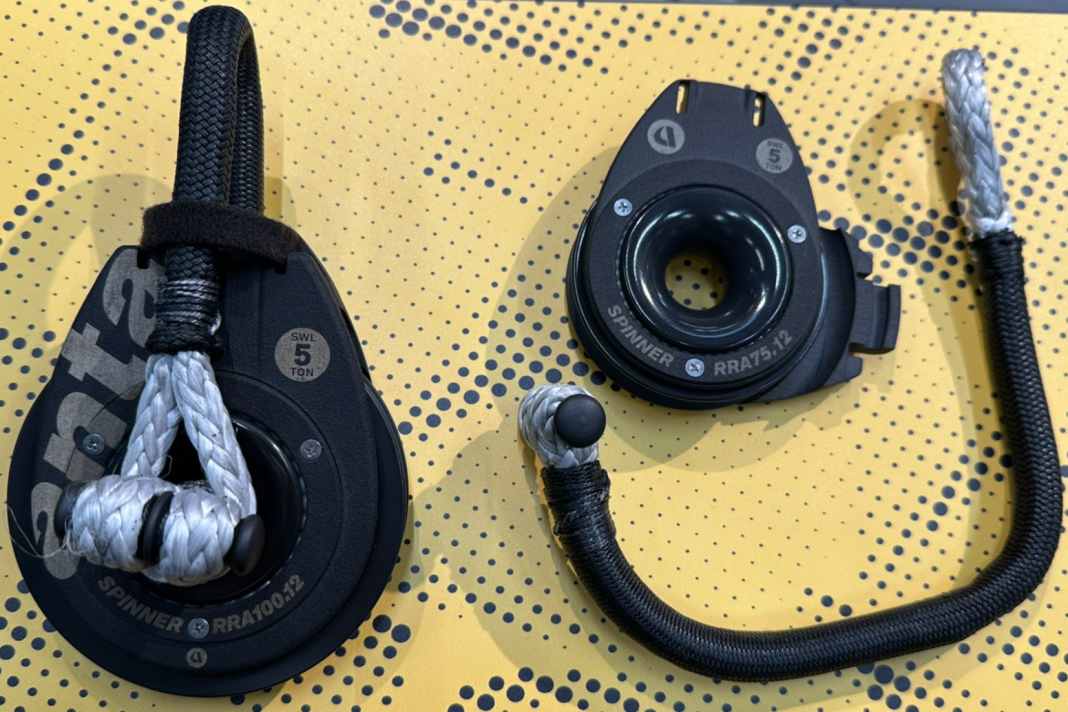





Conductive deck equipment
High-load snatch blocks from Antal and Easysea come from Italy, both of which use Dyneema loops as the load-bearing part. Although the blocks look similar on the outside, there are differences, especially when it comes to storage. Although the Olliblock from Easysea looks like a thimble, it uses a maintenance-free plain bearing for its aluminium disc. The housing is made of Delrin and is designed to prevent scratches on the deck. The disc diameter is 50 millimetres and the working load is specified as 900 kilograms, with a block weight of 181 grams. The central passageway can be used as a dogbane. Antal's spinner is actually based on an aluminium thimble that runs directly on the Dyneema. The ball bearing, which is visible from the outside, only serves to reduce friction on the side parts of the block. As with the Olli, the housing of the spinner can be opened by turning it to insert a line. Antal states that the working load is a whopping five tonnes, although the actual value depends on the quality of the Dyneema loops. The value refers to the sling sold by Antal and manufactured by Maffioli. Disc diameters of 75 and 100 millimetres are available. The prices for the blocks have not yet been finalised.
Roller shutters from Barton and Profurl
Both Profurl and Barton have shown new headsail furling systems. Profurl now also offers the NEX series endless furling systems with a conventional reefing drum. The system is called NEX-Drum and was originally developed for Class 40 regatta yachts. Compared to the endless system, there are no problems with slipping reefing lines and only a simple line guide is required. The NEX drum systems are designed to set and retrieve staysails, gennakers and code Zeros. As is usual with Profurl, the bearings are maintenance-free, sealed steel ball bearings. The systems are not suitable for reefing. Three sizes are available for sail areas of up to 240 square metres. Price: from 1750 euros.
Barton, on the other hand, has opted for an endless furler for small yachts and keelboats. It bears the name HBT-1, is made of aluminium and weighs just 175 grams. The system is equipped with a combination of plain and ball bearings, which should ensure smooth running even under heavy loads. Thanks to a specially shaped disc with three segments, the reefing line should be held particularly securely. The line can also be inserted without tools. Prices have not yet been finalised.
Exclusive guide eye, universal genoa slides
The double guide eye from Rigging Projects, known as the Switch Lead, can be opened to insert the operating line of an endless furler, for example. To do this, simply loosen the central knurled screw a few turns. The top can then be swivelled open. The maximum line diameter is 12 millimetres. The English company is asking a proud 1270 pounds for this fine part, which is produced in a small series.
The GT and HD series genoa sliders from Barton are likely to be significantly cheaper. They are designed for classic T-rails and are built to last. They replace the slides that have been tried and tested for decades with a more modern design. Variants are available for 25 and 35 mm rails, both with pin-stop and for line adjustment. Sliding inserts ensure smooth running on the rail. The sheet roller is also mounted on plain bearings. Prices have not yet been finalised.
Illuminated crank
The benefits of the Speedylight winch crank from Antal only become apparent at second glance. From the outside, it appears to be the familiar quick-release crank from the Italians. The highlight is the integrated lighting. It shines downwards and can be illuminated in either white or red. On the one hand, this allows atmospheric cockpit lighting to be realised and, on the other hand, the crank can be easily found in the dark. Prices are not yet known.
Powerful clamp
French fittings specialist Kaver presents the KJS12, a very compact halyard stopper with enormous holding forces. Made from stainless steel and aluminium, the clamp is designed for rope diameters of up to 12 millimetres and is designed to hold up to 1.2 tonnes. The breaking load is two tonnes. These high values are achieved by two keel-shaped jaws that press further and further onto the line under load. The construction is designed for low rope wear and easy maintenance. The entire inner workings can be pulled out of the housing after loosening two screws without having to remove it from the deck. Operation is via a pull loop, so the clamp can easily be fitted with a remote release. However, the halyard must be winched on before the clamp can be opened. The price is 196 euros.

